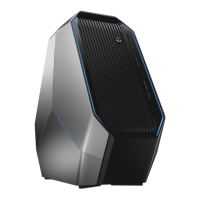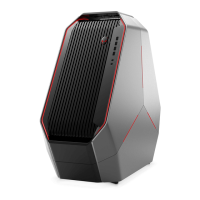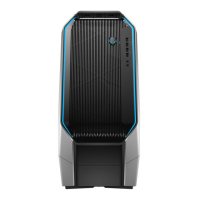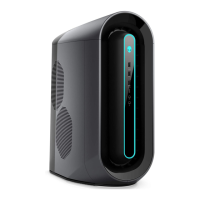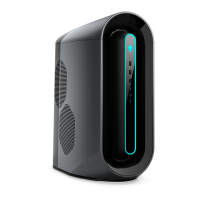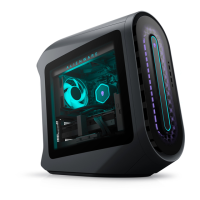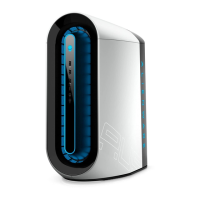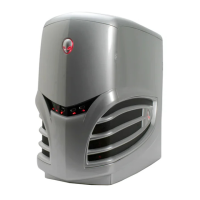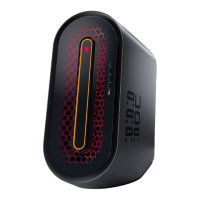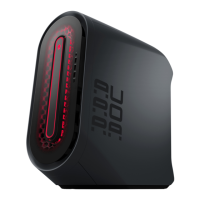Do you have a question about the Alienware Area 51 and is the answer not in the manual?
Detailed identification and description of components on the computer's front panel.
Detailed identification and description of ports and connectors on the computer's rear panel.
Physical dimensions and maximum weight of the computer system.
Identifies the specific computer model name and its variant.
Details on the processor and chipset used in the computer.
Details on memory slots, type, speed, and supported configurations.
Listing and description of all external network, USB, audio/video, and media card ports.
Details on internal M.2 slots for WLAN/Bluetooth and storage, plus SATA ports.
Information on Ethernet controller and wireless communication standards (Wi-Fi, Bluetooth).
Specifications for the wireless module, including transfer rate, frequency bands, and encryption.
Details about the audio controller and its type, including channel configuration.
Information on supported graphics card types and controller options.
Details on externally and internally accessible drive bays for storage devices.
Technical specifications for power supply units, including voltage, frequency, current, and output.
Environmental operating and storage conditions, including temperature, humidity, vibration, and altitude.
Detailed identification and description of components on the computer's front panel.
Detailed identification and description of ports and connectors on the computer's rear panel.
Physical dimensions and maximum weight of the computer system.
Identifies the specific computer model name and its variant.
Details on the processor and chipset used in the computer.
Details on memory slots, type, speed, and supported configurations.
Listing and description of all external network, USB, audio/video, and media card ports.
Details on internal M.2 slots for WLAN/Bluetooth and storage, plus SATA ports.
Information on Ethernet controller and wireless communication standards (Wi-Fi, Bluetooth).
Specifications for the wireless module, including transfer rate, frequency bands, and encryption.
Details about the audio controller and its type, including channel configuration.
Information on supported graphics card types and controller options.
Details on externally and internally accessible drive bays for storage devices.
Technical specifications for power supply units, including voltage, frequency, current, and output.
Environmental operating and storage conditions, including temperature, humidity, vibration, and altitude.
The Alienware Area-51 R3 is a high-performance desktop computer designed for gaming and demanding tasks, featuring a distinctive chassis and a range of connectivity options. Its primary function is to serve as a powerful computing platform, capable of handling intensive applications, virtual reality (VR) experiences, and multi-monitor setups.
The Alienware Area-51 R3 functions as a robust desktop computer, providing users with a powerful platform for various computing needs. At its core, it processes data and executes software applications, ranging from everyday productivity tools to high-fidelity games and professional creative suites. The system is designed to support advanced graphics configurations, including multiple PCI-Express graphics cards, which are crucial for rendering complex visuals in games and VR environments. It also integrates comprehensive audio capabilities, allowing for immersive sound experiences through multiple output channels. The computer facilitates network connectivity through both wired Ethernet and wireless Wi-Fi and Bluetooth, ensuring versatile communication options. Storage is managed through a combination of optical drives, traditional hard drives, and faster solid-state drives, providing ample space and quick access to data. The inclusion of numerous USB ports, including USB 3.1 Gen 1, USB 3.1 Gen 2, and a USB 3.1 Gen 2 Type-C port with PowerShare, enables extensive peripheral connectivity and efficient data transfer. The PowerShare feature on the Type-C port allows users to charge USB devices even when the computer is turned off, adding a layer of convenience. The system's power supply is designed to support its high-performance components, with diagnostic features to help monitor its status.
The Alienware Area-51 R3 offers several usage features that enhance its user experience. Setting up the computer is straightforward, involving connecting essential peripherals like the keyboard, mouse, and display. The system guides users on connecting the display to the discrete graphics card, emphasizing optimal performance for visual output. For users with multiple graphics cards, the manual clarifies which slot serves as the primary graphics card, ensuring correct setup. The power button, prominently featuring the Alienhead logo, serves multiple functions: turning the computer on, putting it to sleep, or forcing a shutdown with a prolonged press. Users can customize the power-button behavior through Power Options, tailoring it to their preferences.
The front panel of the computer provides convenient access to frequently used ports and drives. It includes an optical-drive eject button and the optical drive itself for reading and writing CDs and DVDs. Headphone and microphone ports are readily available for audio input and output, catering to communication and entertainment needs. Two USB 3.1 Gen 1 ports on the front allow for quick connections of storage devices, printers, and other peripherals, offering data transfer speeds up to 5 Gbps. A media-card reader is also integrated, providing easy access to data from various media cards.
The back panel of the Area-51 R3 is equipped with a comprehensive array of ports to support a wide range of devices. A unique "Rear I/O accessibility lighting button" illuminates the back panel ports, making it easier to connect cables in dimly lit environments. The back panel includes multiple USB 3.1 Gen 1 ports, a USB 3.1 Gen 2 port, and a USB 3.1 Gen 2 Type-C port with PowerShare, offering high-speed data transfer and charging capabilities. It also features a hard-drive activity light to indicate when the computer is reading from or writing to the hard drive. For audio, the back panel provides rear L/R surround, side L/R surround, line-out, line-in, and center/subwoofer ports, along with an optical S/PDIF port for digital audio output, supporting integrated 7.1 channel audio. Two network ports (RJ45) ensure reliable wired internet connectivity. Additionally, two USB 2.0 ports are available for connecting older peripherals.
For virtual reality (VR) enthusiasts, the Alienware Area-51 R3 is designed to support VR headsets. The setup process involves downloading and running specific VR headset setup tools from Dell's support website. Users are instructed to connect the VR headset to any USB 3.1 Gen 1 port and the HDMI port on the discrete graphics card, ensuring optimal performance for VR applications. The manual explicitly notes that the Type-C port primarily provides USB data functions and does not support alternate video or Thunderbolt modes, guiding users on appropriate port usage.
While the manual primarily focuses on setup and specifications, it implicitly touches upon maintenance through its design and information provided. The "Regulatory label" on the back panel contains regulatory information, which is important for compliance and potential troubleshooting. The "Service Tag label" is a crucial maintenance feature, as it provides a unique alphanumeric identifier that Dell service technicians use to identify hardware components and access warranty information. This tag is essential for obtaining support and facilitating repairs or upgrades.
The "Security-cable slot (for Kensington locks)" and the "Security-cable slot latch" are physical features that contribute to the security and, by extension, the longevity of the device by deterring theft. While not directly a maintenance task, securing the computer can prevent physical damage or loss, which would otherwise necessitate maintenance or replacement.
The "Power-supply diagnostics button" and "Power-supply diagnostics light" are integrated diagnostic tools. These features allow users to quickly check the power-supply state, which can be helpful in diagnosing power-related issues without needing to open the chassis or perform complex troubleshooting steps. This immediate feedback can guide users in determining if a power supply issue requires further investigation or professional service.
The detailed specifications provided, such as dimensions, weight, and environmental operating conditions (temperature, humidity, vibration, shock, and altitude), offer insights into the computer's robust design and its ability to withstand various conditions. Understanding these parameters can help users ensure the computer is operated within its recommended environment, thereby contributing to its long-term reliability and reducing the need for premature maintenance. The information on internal ports, such as M.2 slots for WLAN, Bluetooth, and solid-state drives, and SATA ports for storage, indicates the expandability and upgradeability of the system, allowing for future maintenance and performance enhancements. The PCI-Express graphics card installation matrix provides guidance for installing and configuring multiple graphics cards, which can be part of an upgrade or maintenance routine to enhance graphical performance.
| Memory slots | 4x DIMM |
|---|---|
| Internal memory | 8 GB |
| Memory channels | Quad-channel |
| Memory clock speed | 2133 MHz |
| Internal memory type | DDR4-SDRAM |
| Maximum internal memory | 32 GB |
| HDD size | 3.5 \ |
| HDD speed | 7200 RPM |
| HDD capacity | 2000 GB |
| SSD capacity | 128 GB |
| HDD interface | SATA III |
| Storage media | HDD+SSD |
| Optical drive type | DVD Super Multi |
| Card reader integrated | Yes |
| Total storage capacity | 2128 GB |
| Compatible memory cards | MMC, MMC+, MS PRO, MS PRO Duo, Memory Stick (MS), SD, SDHC, SDIO, SDXC |
| Number of HDDs installed | 1 |
| Number of storage drives installed | 2 |
| Wi-Fi standards | 802.11a, Wi-Fi 5 (802.11ac), 802.11b, 802.11g, Wi-Fi 4 (802.11n) |
| Bluetooth version | 4.0 |
| Cabling technology | 10/100/1000Base-T(X) |
| Top Wi-Fi standard | Wi-Fi 5 (802.11ac) |
| Ethernet LAN data rates | 10, 100, 1000 Mbit/s |
| DVI port | No |
| USB 2.0 ports quantity | 4 |
| VGA (D-Sub) ports quantity | - |
| USB 3.2 Gen 1 (3.1 Gen 1) Type-A ports quantity | 6 |
| USB 3.2 Gen 2 (3.1 Gen 2) Type-A ports quantity | 0 |
| PCI Express x16 (Gen 3.x) slots | 3 |
| Chassis type | Tower |
| Product color | Silver |
| Placement supported | Vertical |
| Cable lock slot type | Kensington |
| Audio system | Creative Sound Core3D |
| Product type | PC |
| Motherboard chipset | Intel® X99 |
| Audio output channels | 5.1 channels |
| Power supply input voltage | 100 - 240 V |
| Power supply input frequency | 50 - 60 Hz |
| Operating altitude | -15.2 - 3048 m |
| Non-operating altitude | -15.2 - -10668 m |
| Storage temperature (T-T) | -40 - 65 °C |
| Operating temperature (T-T) | 5 - 35 °C |
| Storage relative humidity (H-H) | 0 - 95 % |
| Operating relative humidity (H-H) | 10 - 90 % |
| Operating system installed | Windows 8.1 |
| Operating system architecture | 64-bit |
| Tcase | 66.8 °C |
| Bus type | QPI |
| Tjunction | - °C |
| Processor cache | 15 MB |
| Processor model | i7-5820K |
| System bus rate | 0 GT/s |
| Processor family | Intel® Core™ i7 X-series |
| Processor series | Intel Core i7-5800 Desktop Series |
| Processor socket | LGA 2011-v3 |
| Processor threads | 12 |
| Processor codename | Haswell E |
| Processor frequency | 3.3 GHz |
| Processor cache type | Smart Cache |
| Configurable TDP-down | - W |
| Processor lithography | 22 nm |
| Processor manufacturer | Intel |
| Processor front side bus | - MHz |
| PCI Express slots version | 3.0 |
| Processor boost frequency | 3.6 GHz |
| Thermal Design Power (TDP) | 140 W |
| Maximum number of PCI Express lanes | 28 |
| Memory types supported by processor | DDR4 1333/1600/2133 |
| Memory voltage supported by processor | - V |
| Memory clock speeds supported by processor | 1333, 1600, 2133 MHz |
| Memory bandwidth supported by processor (max) | 68 GB/s |
| Maximum internal memory supported by processor | 64 GB |
| CUDA cores | 1664 |
| Discrete graphics card model | NVIDIA® GeForce® GTX 970 |
| On-board graphics card model | Not available |
| Discrete graphics card memory | 4 GB |
| Discrete graphics memory type | GDDR5 |
| Scalability | 1S |
| Processor code | SR20S |
| Processor ARK ID | 82932 |
| Processor package size | 52.5 x 45.0 mm |
| Graphics & IMC lithography | - nm |
| Supported instruction sets | SSE4.2, AVX 2.0, AES |
| Intel Identity Protection Technology version | 1.00 |
| Depth | 272.71 mm |
|---|---|
| Width | 638.98 mm |
| Height | 569.98 mm |
| Weight | 28000 g |
